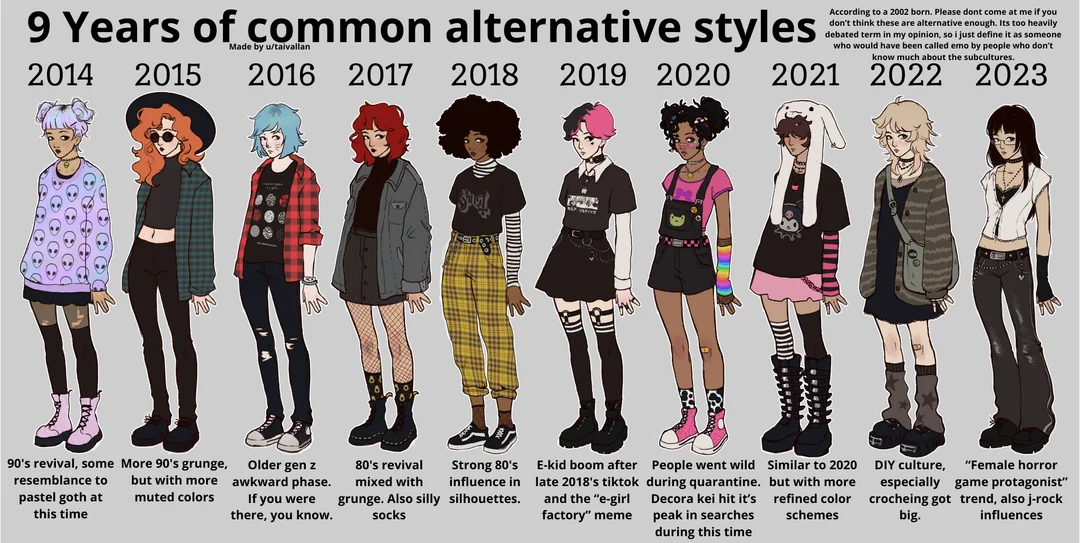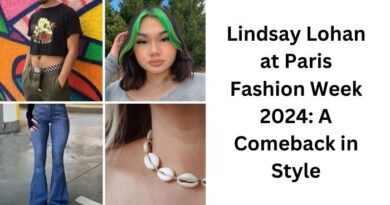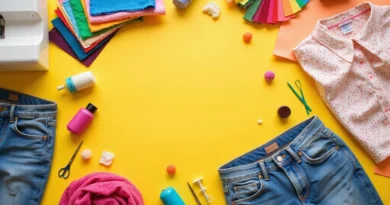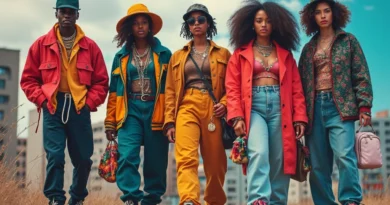9 Years of Alternative Fashion: A Visual Timeline That’s Way Too Accurate
Fashion is always changing, but alternative fashion? That’s an entirely different beast. A viral Reddit post recently caught the internet’s attention with an illustration that showcases 9 years of alternative fashion trends and the results are scarily accurate.
Created by u/talvallan, the image is basically a time capsule of how Gen Z’s alternative aesthetic has evolved since 2014. From soft grunge to Y2K revival, it’s all here. The best part? Redditors chimed in with their own thoughts, nostalgia, and—of course—a bit of friendly debate.
Let’s break it down, year by year.

2014: 90s Revival with a Touch of Pastel Goth
The early 2010s saw a huge Tumblr aesthetic movement, and 2014 was no exception. Think pastel goth, oversized sweaters, thigh-high socks, and soft grunge elements—basically, the kind of outfits that screamed Lana Del Rey fan with a side of American Horror Story obsession.
2015: More 90s Grunge, But Muted
Grunge wasn’t going anywhere, but in 2015, the colors got darker and muted earth tones took over. Flannels, ripped skinny jeans, oversized cardigans, and round sunglasses became a staple for anyone deep into their aesthetic phase. If you weren’t layering chokers, were you even dressing alternative?
One Redditor chimed in: “I have seen 2015 and 2016 looks in real life.”
2016: The Awkward Phase
Ah, 2016. The era of older Gen Z experimenting with alternative fashion, trying to find their thing. This year saw a mix of throwback grunge and indie sleaze, with messy hair, band tees, and that “I just raided my dad’s closet” energy. Think of this as the last gasp of early Tumblr alternative fashion before things took a turn.
2017: 80s Revival with a Side of Grunge
Out with the 90s, in with the 80s—kind of. 2017 saw a resurgence of 80s silhouettes mixed with grunge elements. Striped long sleeves under band tees, plaid pants, and fishnet stockings were everywhere. People were still trying to perfect that “effortlessly cool” look while adding a little retro edge.
2018: Full 80s Influence
By 2018, 80s fashion wasn’t just an influence—it was the look. Wide-leg pants, oversized blazers, strong silhouettes, and thrifted aesthetics took over. Silly socks became a thing. The whole “mixing vintage with modern” aesthetic was born, and indie kids ran with it.
2019: The Rise of E-Kids
The E-girl and E-boy explosion happened in late 2018, but by 2019, it was everywhere. Tiktok was flooded with black-and-white outfits, striped sleeves, chains, platform boots, and dyed hair. The “E-girl factory” aesthetic took over, and people embraced the digital goth-meets-gamer-meets-scene kid hybrid look.
One Redditor pointed out: “E-kid boom after late 2018’s TikTok and the ‘E-girl factory’ meme.”
2020: Quarantine Fashion Chaos
With everyone stuck inside, fashion got weird. Hyperpop aesthetics, DIY clothing, Decora Kei, and early 2000s nostalgia surged in popularity. People layered colorful accessories, wore oversized tees, and experimented with bolder looks—because when you’re mostly dressing for the internet, why not go all out?
2021: A More Refined Version of 2020
The quarantine aesthetic didn’t disappear in 2021, but it became more polished. Think less chaotic layering, more intentional styling. The bunny hat trend peaked, platform boots were still a must, and people refined their quarantine looks into something wearable outside.
One user noted: “I like the clear split between 2020/2021 and 2022/2023. In the former, quarantine internet aesthetics exploded.”
2022: DIY Culture Takes Over
Post-quarantine, people took what they learned and toned it down. DIY culture—especially crocheting—became a huge trend, and alternative fashion shifted to a more subdued, thrifted, and wearable style. The extreme aesthetics of 2019-2021 settled into a more casual, streetwear-friendly alt look.
2023: The “Female Horror Game Protagonist” Era
The final entry in this timeline is the “female horror game protagonist” aesthetic—which might be the best description of a fashion trend ever. J-Rock influences, all-black outfits, layered accessories, and a mix of tough-but-refined streetwear set the tone for 2023’s alternative style.
One commenter summed it up perfectly: “The 2021-2023 fashion looks more like cosplay.”
What Reddit Thinks About This Timeline
Redditors had a lot to say about this spot-on fashion breakdown. Some were nostalgic, others loved the analysis, and a few debated the legitimacy of certain trends. Here’s what they had to say:
“Extremely well done. Love the cultural descriptions of what’s going on. You’re clever.”
“I love how you were able to describe each era, and the art is absolutely amazing—thank you for sharing this.”
“2021-2023 looks more like cosplay to me.”
“I like the clear split between 2020/2021 and 2022/2023. Quarantine aesthetics exploded, but people had to dress more ‘normal’ when coming back into the real world.”
Even the OP, u/talvallan, chimed in:
“Please keep in mind that I am no expert. I wanted to draw what I mostly saw during each year, so it’s by nature quite subjective. Happy New Year’s, everyone!”
Final Thoughts: Fashion Is a Time Capsule
Whether you lived through these fashion phases or just love analyzing trends, this timeline proves that alternative fashion is constantly evolving. What was once Tumblr-core became TikTok-core, and who knows what 2024 will bring?
One thing’s for sure: everything comes back eventually. So if you’re still hoarding your 2014 pastel goth outfits… you just might be ahead of the curve.
What do you think? Which year’s style is your favorite? Let us know in the comments!
Source: Reddit
Explore more fashion posts here



